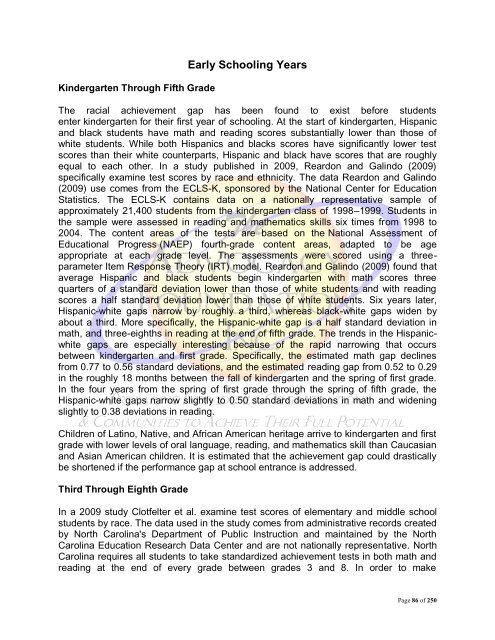Institutional Racism
Institutional Racism
Institutional Racism
You also want an ePaper? Increase the reach of your titles
YUMPU automatically turns print PDFs into web optimized ePapers that Google loves.
Kindergarten Through Fifth Grade<br />
Early Schooling Years<br />
The racial achievement gap has been found to exist before students<br />
enter kindergarten for their first year of schooling. At the start of kindergarten, Hispanic<br />
and black students have math and reading scores substantially lower than those of<br />
white students. While both Hispanics and blacks scores have significantly lower test<br />
scores than their white counterparts, Hispanic and black have scores that are roughly<br />
equal to each other. In a study published in 2009, Reardon and Galindo (2009)<br />
specifically examine test scores by race and ethnicity. The data Reardon and Galindo<br />
(2009) use comes from the ECLS-K, sponsored by the National Center for Education<br />
Statistics. The ECLS-K contains data on a nationally representative sample of<br />
approximately 21,400 students from the kindergarten class of 1998–1999. Students in<br />
the sample were assessed in reading and mathematics skills six times from 1998 to<br />
2004. The content areas of the tests are based on the National Assessment of<br />
Educational Progress (NAEP) fourth-grade content areas, adapted to be age<br />
appropriate at each grade level. The assessments were scored using a threeparameter<br />
Item Response Theory (IRT) model. Reardon and Galindo (2009) found that<br />
average Hispanic and black students begin kindergarten with math scores three<br />
quarters of a standard deviation lower than those of white students and with reading<br />
scores a half standard deviation lower than those of white students. Six years later,<br />
Hispanic-white gaps narrow by roughly a third, whereas black-white gaps widen by<br />
about a third. More specifically, the Hispanic-white gap is a half standard deviation in<br />
math, and three-eighths in reading at the end of fifth grade. The trends in the Hispanicwhite<br />
gaps are especially interesting because of the rapid narrowing that occurs<br />
between kindergarten and first grade. Specifically, the estimated math gap declines<br />
from 0.77 to 0.56 standard deviations, and the estimated reading gap from 0.52 to 0.29<br />
in the roughly 18 months between the fall of kindergarten and the spring of first grade.<br />
In the four years from the spring of first grade through the spring of fifth grade, the<br />
Hispanic-white gaps narrow slightly to 0.50 standard deviations in math and widening<br />
slightly to 0.38 deviations in reading.<br />
Children of Latino, Native, and African American heritage arrive to kindergarten and first<br />
grade with lower levels of oral language, reading, and mathematics skill than Caucasian<br />
and Asian American children. It is estimated that the achievement gap could drastically<br />
be shortened if the performance gap at school entrance is addressed.<br />
Third Through Eighth Grade<br />
In a 2009 study Clotfelter et al. examine test scores of elementary and middle school<br />
students by race. The data used in the study comes from administrative records created<br />
by North Carolina's Department of Public Instruction and maintained by the North<br />
Carolina Education Research Data Center and are not nationally representative. North<br />
Carolina requires all students to take standardized achievement tests in both math and<br />
reading at the end of every grade between grades 3 and 8. In order to make<br />
Page 86 of 250

















